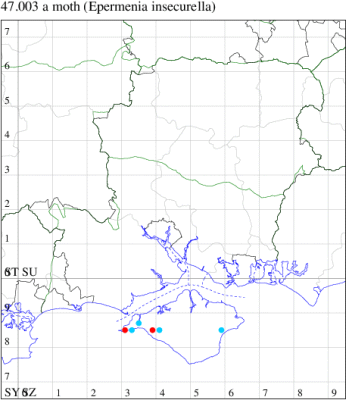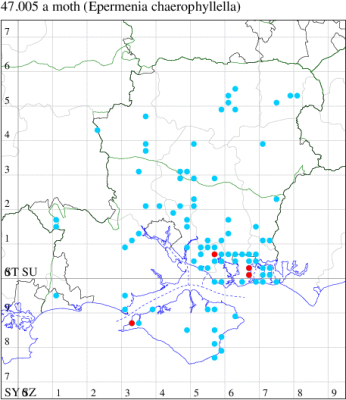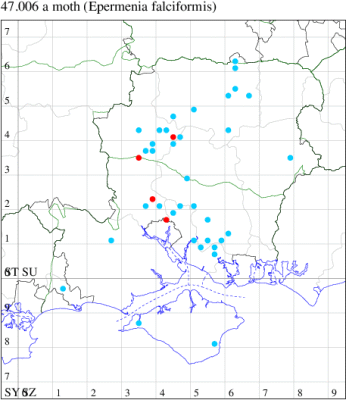2021 Annual Report for: Epermeniidae / Epermeniinae
For species seen in 2021 that had less than or equal to 100 records, full details are included; for more common species, the earliest, latest and highest count by vice-county are shown. The narrative for each species is taken from the main Hantsmoths website, and it is possible that some information on abundance and occurrence can get out of date, as it is impossible to keep up with all changes; however it should give a good introduction to each species. The tables in each species account summarise the previous status, and that for the current year.
For the maps, all records prior to 2021 are shown by a blue dot (the larger the dot, the more recent), with the current year's records shown in red. As previous records are superimposed on any report for 2021, new sites have greater emphasis (i.e. will show as 'more red').
In the species accounts, an asterisk next to a location indicates a new 10km square record; earliest ever dates are highlighted in orange, and latest ever in red. Initials in the species accounts refer to the recorders listed here. Please get in touch if you identify any omissions or errors, in particular if you have records that have yet to be submitted. Details of how to submit records can be found here.
47.003 [B&F: 0482] Epermenia insecurella (Stainton, 1849) - pRDB2
Vulnerable (proposed as a future Red Data Book species) on limestone grassland and chalk downland in England, south of a line from the Severn estuary to The Wash, a priority species under the UK Biodiversity Action Plan. In our area there are four very old records on the Isle of Wight, until rediscovered on Mottistone Down on the island in May 2018. Wingspan 9-11 mm. Flies in late afternoon sunshine. Larva feeds on Bastard Toadflax Thesium humifusum.
Records prior to 2021
| Vice County | #Records | #Individuals | First Record | Last Record |
|---|---|---|---|---|
| 10 | 5 | 5 | 1850 | 2018 |
2021 records
| Vice County | #Records | #Individuals | Max Quantity |
|---|---|---|---|
| 10 | 4 | 10 | 5 |

Records by year
Records by week (adult)
Records by week (larval)
Record Details
VC10: High Down: Main Bench, larva, five, field observation, larvae (and also a pupa) in a plant of Thesium humifusum: found by looking for the rather inconspicuous silk webbing, larvae generally close to the base of the plant, 28 Jun; pupa, one, field observation, found at the very base of a plant of Thesium humifusum that also had at least 5 larvae: adult was reared emerging on 6th July 2021 and released, 28 Jun; Brook Down, larva, three, field observation, larvae in two fine inconspicuous larval webs in plants of Thesium humifusum growing on the undulating slopes and ridges, 04 Jul; one, 07 Jul (PBar)
47.005 [B&F: 0483] Epermenia chaerophyllella (Goeze, 1783) - Common
Common in rough ground, hedgerows and damp grassland throughout much of the British Isles. In Hampshire reasonably common in the south-east, but less frequently recorded in the north of the county, and distinctly uncommon on the Isle of Wight. Wingspan 12-13 mm. Larva mines leaves of Hogweed, Wild Parsnip, Cow Parsley, Wild Angelica and Wild Carrot, subsequently feeding gregariously in a slight web.
Records prior to 2021
| Vice County | #Records | #Individuals | First Record | Last Record |
|---|---|---|---|---|
| 10 | 35 | 27 | 1900 | 2020 |
| 11 | 400 | 353 | 1972 | 2020 |
| 12 | 31 | 20 | 1988 | 2016 |
2021 records
| Vice County | #Records | #Individuals | Max Quantity |
|---|---|---|---|
| 10 | 1 | 1 | 1 |
| 11 | 3 | 2 | 1 |

Records by year
Records by week (adult)
Records by week (larval)
Record Details
VC10: Totland, one, 24 Jul (RTer);
VC11: Fareham, one, 12 Jun (MLO); Great Salterns NR, Portsmouth, larva, present, field observation, 30 Sep (MRY, JRL); Portsmouth, one, 06 Sep (IRT)
47.006 [B&F: 0481] Epermenia falciformis (Haworth, 1828) - Local
Local in damp woodland, marshes and freshwater margins throughout much of southern England, rarely in Wales. In Hampshire locally common only at Ampfield and Emer Bog, and also at Botley Wood. Not recorded from the Isle of Wight since 1900. Wingspan 12-14 mm. Like several other Epermenia species, the dorsum has a number of prominent hump-like scale-teeth, in E. falciformis there are two, occasionally three, black scale-teeth, the largest one at one-third (MBGBI Vol 3). Larva feeds within stems and leaves of Wild Angelica and Ground Elder, living within a spun or rolled leaf.
Records prior to 2021
| Vice County | #Records | #Individuals | First Record | Last Record |
|---|---|---|---|---|
| 10 | 2 | 1 | 1900 | 2013 |
| 11 | 50 | 58 | 1976 | 2016 |
| 12 | 32 | 58 | 1981 | 2020 |
2021 records
| Vice County | #Records | #Individuals | Max Quantity |
|---|---|---|---|
| 11 | 3 | 3 | 1 |
| 12 | 1 | 1 | 1 |

Records by year
Records by week (adult)
Records by week (larval)
Record Details
VC11: Romsey, one, 19 Jun (NRJ); Stockbridge Down NT, one, 05 Sep (GCE); Swaythling, Southampton, one, 29 Aug (MEdg);
VC12: Bullington, one, 24 Aug (GCE)